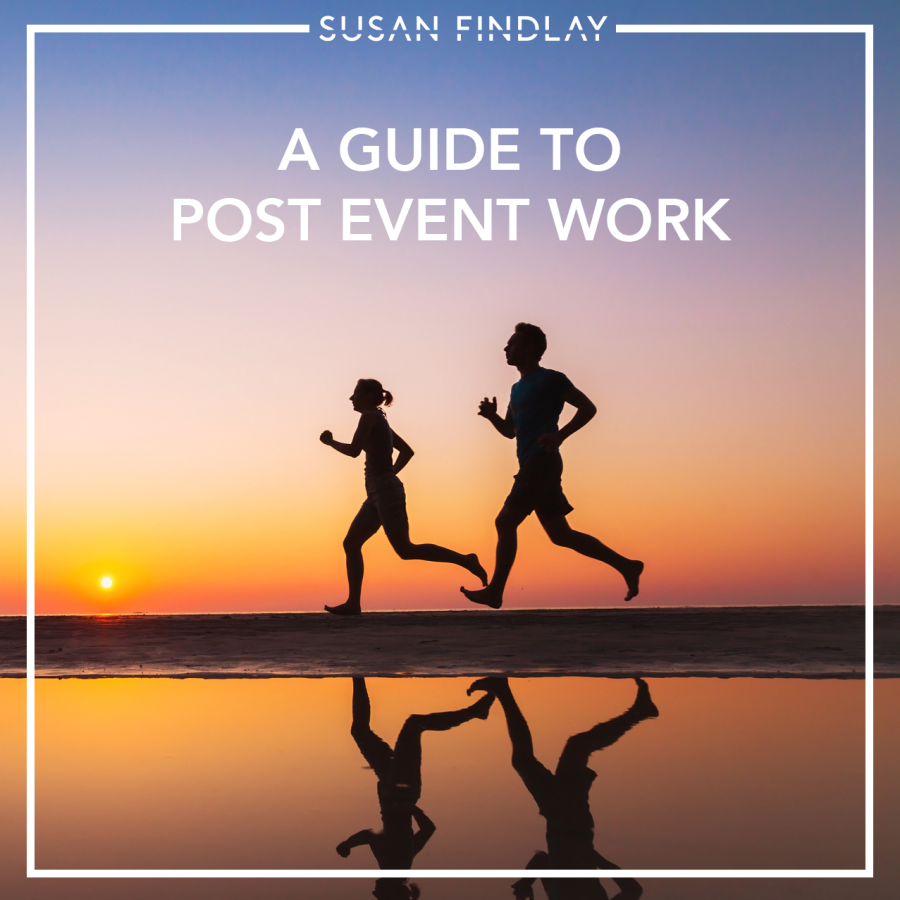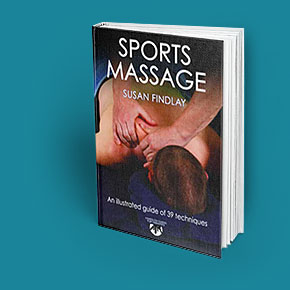Excerpts from Sports Massage, a hands-on guide for therapists… by Susan Findlay
Event work can be rewarding, challenging, and have an air of excitement. It also provides an opportunity to demonstrate your skills to potential clients. Many of my graduates use event work as an opportunity to network, get their foot in the door, gain experience and generally immerse themselves in the sport of their choice. The downside can consist of poor working conditions with low or non-existent monetary rewards, working non-stop and long hours. On the flip side you will be making a difference in an athletes recovery, meeting amazing people and hearing their stories, making connections, watching the events and being a part of the excitement, overall it is an unforgettable experience and well worth doing.
Post-event Massage
When is post event massage appropriate? One of the main purposes of post-event massage is to bring the tissues back to a pre-event state by applying general massage or stretching techniques. During this time it is important to be observant and identify any injuries, or conditions that need first aid or further medical attention. If there isn’t a medical team available to do the post-event assessments, you will need to include some time to do a consultation prior to starting the massage. It is important as a massage therapist that you are aware of the signs and symptoms of the more common problems and are equipped to deal with them. It is also relevant to determine if they have any pre-existing medical conditions such as diabetes, in this case an insulin dependant diabetic will need to be aware of the potential effects that exercise and massage can affect their insulin levels, they might need to make further adjustments before receiving massage.

Post-event and Pre Massage Interview Questions
Even if someone has already completed a post event assessment it’s important to ask questions that can help you plan your treatment. At this point any contraindications should have been ruled out i.e. any symptoms of hyper or hypothermia. Your next set of questions will help you determine what techniques are appropriate, how long should the session be, what areas of the body need attention, what modifications need to be made that will best serve your client. Some examples of the sort of questions you might ask include:
- Have you completed your post-event cool down?
- Did you have any problems during the course of the event?
- Can you identify any areas of pain or soreness?
- Are you feeling hot, warm or cold?
- Have you had a post event hydration drinks or nutrition?
- Do you suffer with any of the following symptoms: dizziness, headaches, confusion, unsteadiness and/or nausea.
In addition to asking these questions, you need to be aware of other common post-event conditions, as they will influence the treatment you give.
- Blisters (long distance running)
- Contusions (associated with contact sports)
- Cramps (spasms)
- Dehydration & Hyponatremia
- Heat Exhaustion
- Hyperthermia & Hypothermia
- Open wounds
- Sprains
- Strains
If you are qualified to give first aid certificate and the injuries are minor, you can treat as appropriate. When in doubt, refer. If there is a health team available, typically they will be at the forefront, screening clients and taking care of these situations, but often the massage therapist is the only one available and will be expected to have the appropriate training to support this. The more serious conditions should always be sent to a medical facility.
Post-event massage can serve several functions.
- Help to highlight any injuries or tissue damage
- Assist in normalizing tissue
- Restore muscle tone
- Restore resting muscle length
- Encourage blood flow to any congested areas
- Reduce muscle soreness
- Restore flexibility
- Relieve muscle cramps or spasms
- Support metabolic recovery
When can post-event massage take place?
Post exercise recovery research is demonstrating that massage “may be more beneficial in acute short term recovery (5-10 min postmassage) compared to longer recovery periods (>1-6 hour postmassage)” (1) but massage can still be very beneficial over a period of a couple of days. The duration of the massage will be 15 to 20 minutes. The greater the time it is away from the event, the longer the massage can be.
Which techniques are appropriate?
Several techniques can be used during post-event massage sessions but most need to be modified depending on the events duration and type. For instance, if it is at a marathon your techniques will need to be slower, more superficial and the timing shorter in duration. After a lengthy event such as running 26.2 miles, your clients tissue needs time to recover, hence, your massage needs to reflect this and be less demanding. This is quite different from the preparatory sessions that focus on helping your clients to perform at their best and treatment is usually based on function.
Technique suggestions and possible modifications:
- Effleurage – more superficial and you might want to combine with a little light vibration
- Petrissage – less assertive, more flowing in nature, avoid squeezing with your fingertips
- Gentle compression – slow this down and adjust the depth, melt rather than push through
- Stretching – especially effective for situations when the muscles cramp
- General massage application rather than specific treatment to assist recovery
- Superficial depth – ask your clients for their feedback using a number scale
- Lymphatic drainage (as in assisting the return of tissue homeostasis)
 Organising an Event
Organising an Event
Organising any event can be very demanding no matter the size. It requires good organizational and communication skills. And, at times, a great deal of diplomacy. It does not usually have a large monetary value attached to it, but it is an experience that does offer opportunities to develop as a therapist and to make connections with fellow colleagues. There can be a promotional nature of your own services, especially if you do events close to your own turf.
Where can you organize an event? It ranges from any of the major events to local clubs. At the beginning of your career, or during your studies, it is recommended that you volunteer at a few supervised events so that you can get the necessary experience before venturing out on your own.
First Steps
Approach your local club or a charity and offer your services. If there is an event organiser, make sure that there is a need for your services and/or there isn’t already someone hired to do the job. It is important to clearly define your scope of responsibility with the organiser and find out if there are any protocols for this type of service, ie you might not be allowed to charge if it is a charitable event, or there may be restrictions as to where you can work. Get letters of agreement in writing as well supply any necessary documents such as copies of insurance or qualifications. Make sure you’ve also addressed the following:
- Determine the size of the event and the number of participants
- How many massages sessions will need to be provided
- Establish what the protocol is for referring to the medical team
- If appropriate find out who will provide and pay for supplies, transportation and/or parking
- If you’re organizing a team of therapists see if you can secure any freebies such as T-shirts
- Is water or food being provided
- Arrange parking, storage of kit and any other concerns
- What security measures are there, will therapists need identification badges to get into the event
Book your therapists in advance including a few extras, people do cancel, and quite often at the last hour. It is better to have too many, (this way everyone can get breaks) than too few. A result of having too few therapists can lead to your team being overworked and not enjoying the event experience. Also participants can end up being turned away and will share their disgruntlement with the organizers which might result in you not being asked back again for future events.
Remember to thank the organizer and any volunteers for their part on the day.
Organizing the Venue
Event organizers might expect you to provide your own tent and may not have a suitable place for you to work, so be prepared and assess the situation beforehand. Even in the summer it is advisable to have a covered area in which to work for your own comfort as well as the participants. Make sure you are not stuck in a corner where no one can see or find you, it can be the difference between having a successful event or not, it is important that you are central to the activity so people know you are there. Work out in advance how you are going to get there, how long it will take and is there any place to store equipment, ideally ask if you can bring everything down the day before and set up. Make sure you think about these issues, too:
- Arrange tables to accommodate the flow of people
- Set up an area where people can register, sign release forms and wait for their session
- If there is post-event assessment being done by a medical team time will need to be allotted to determine if they are fit for massage
- Set up a rota for breaks – possibly sharing the supervisory/management role
- Put up any signage or banners
- If you have any personal business cards be sure to have them handy
Supplies & Equipment Checklist
Be sure you’re prepared for the event! The success of your event will depend on this. Dress appropriately including layers of clothing in order to accommodate hot and cold conditions. Other considerations and supplies you might need include:
- Treatment couch (if not supplied)
- Pillows or cushions
- Towels – large and small
- Couch roll
- Antiseptic wipes
- Massage lotion
- Bin liners –to put used couch roll in, etc.
- First Aid kit – pins, scissors, adhesive tape, gauze, cold packs, sugary product
- Emergency foil blankets
- Clock to keep an eye on treatment times (or a nurses watch is very useful)
- Business cards, or any advertising you have put together
- Camera to take photos for memorabilia or future advertising
- Water and/or snacks for yourself
- A fully charged mobile phone, but have it on vibration
- Stationary to organize client lists (tickets for bookings)
- Clipboards for filling in forms
- Pens
- A float if you’re charging
If organizing your own event sounds a bit daunting yet you would still like to gain experience you can sign up through your professional association, they should have listed events that you can put your name forward for. Alternatively you can go to one of the organizations below and apply. In most cases they will pay you for your services or at least compensate you for your travel costs if you are a student.
Every therapist would benefit from attending at least one event in their career, it might not be something you’ll want to do again but it will give you an appreciation for the skill it requires, thinking quickly on your feet by being responsive with your techniques to accommodate the conditions, mostly it can be amazingly fun and rewarding.
References
- Massage and post recovery: the science is emerging, Thomas M Best, Scott K Crawford October 27th 2016, published by group.bmj.com
Post-event massage and more is covered in NLSSM’s BTEC Level 5 Diploma in Sports Massage and Remedial Soft Tissue Therapy. Click below to find out more!

